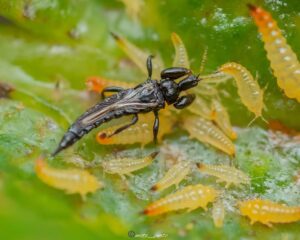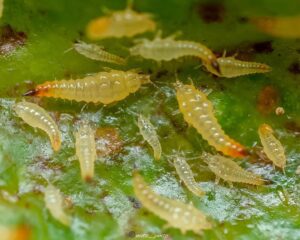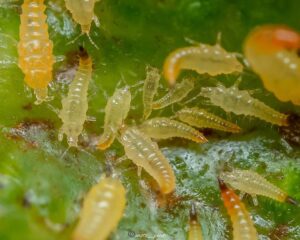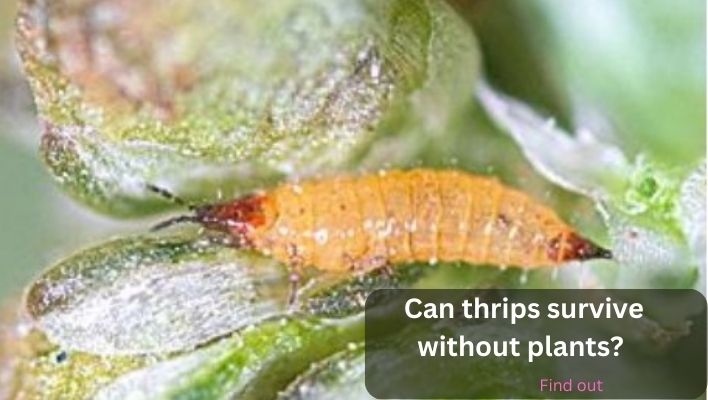Think thrips are just pesky little insects that only survive on plants? They are tiny insects that feed on plants, but can they survive without them? Thrips are small insects that are known for their destructive behavior toward plants.
They feed on plants’ leaves, flowers, and fruits, causing damage that can significantly reduce crop yield. But can thrips survive without plants? The short answer is no; thrips cannot survive without plants. These insects are obligate herbivores, meaning they rely solely on plants for survival.
These tiny bugs have a secret survival strategy that allows them to thrive without their green hosts. In this blog post, we’ll dive deeper into the biology of thrips and explore how they interact with plants.
We will explore the relationship between thrips and plants and investigate the possibility of thrips surviving without a plant-based food source.
We’ll also discuss the potential impact of thrips on agriculture and what can be done to control their populations. So, if you’re a gardener, farmer, or just interested in insects and their environmental impact, keep reading.
How long can thrips live without plants?
Thrips are tiny insects that feed on plants, and they typically have a lifespan of around two to four weeks. They feed by piercing the plant tissue and sucking out the sap. They can cause damage to plants by feeding on the leaves and flowers, and they can also transmit plant viruses.
Without access to plants, thrips will not be able to survive for long. The adult thrips will die within a few days without plants, as they cannot feed and reproduce. The larvae, which are the immature stage of the thrips, will also not be able to survive without plants as they rely on plant material for food.
Thrips also feed on pollen and nectar found in flowers. However, these food sources are insufficient to sustain the thrips for an extended period. Without plants, the thrips will quickly run out of food and cannot survive.
It is also important to note that thrips cannot survive in extremely dry or cold environments. They need a specific range of temperature and humidity to survive. Without plants, the thrips will not be able to survive in these conditions.
In summary, thrips are highly dependent on plants for their survival. Without access to plants, adult thrips will survive only for a few days, and the larvae will not survive. They also need specific temperatures and humidity to survive, so thrips cannot survive long without plants.

Can thrips survive in water?
Thrips, also known as thunder bugs, are small, winged insects that feed on plants. They are known to be able to survive in a variety of environments, including dry and humid conditions. However, their ability to survive in water is limited.
Thrips are not aquatic insects and do not have the adaptations necessary to survive in water for extended periods. They cannot swim or float and do not have the gills or other structures that allow them to extract oxygen from water.
If a thrip falls into the water, it will likely drown within a few minutes. However, if a thrip is on a leaf or other object floating on the surface of the water, it may survive for a short time before eventually drowning.
Overall, thrips are not well-suited to survive in water and are not typically found in aquatic environments. They are better adapted to live on land and feed on plants. If thrips are found in water, it is likely that they have fallen into it by accident and will not be able to survive for long.
Thrips surviving without a plant-based food source
Thrips are small insects that feed on plant sap and other plant tissues. They are commonly found on flowers, leaves, and fruit of many different types of plants. Without a plant-based food source, thrips would not be able to survive.
Thrips have evolved to feed specifically on plants, and their digestive systems are not adapted to consume other types of food. They rely on the nutrients found in plant sap and tissues for their survival, and without these, they would quickly die.
Additionally, thrips use plants for shelter and reproduction, further highlighting their dependence on plants. A few species of thrips feed on other insects, but these are the exception rather than the rule. Even these thrips cannot survive without plants, as they use plants as a food source for the insects they feed on.
Thrips depend highly on plants and cannot survive without a plant-based food source. Without plants, the thrips population would quickly decline, eventually becoming extinct. This is why it is essential to protect and conserve plants, as they play a vital role in maintaining the balance of the ecosystem.

Can thrips survive winter or freezing?
Thrips are also known to be able to survive in a variety of different environments, including cold temperatures. The ability of thrips to survive winter or freezing temperatures depends on the species of thrips and the specific conditions of the environment.
Some species of thrips are able to survive freezing temperatures by entering a state of diapause, where their metabolism slows down significantly, allowing them to survive even in extremely cold temperatures.
Other species of thrips, such as the western flower thrips, are able to survive the winter by seeking out protected areas, such as inside buildings or under leaf litter, where they can survive the cold temperatures.
These thrips can survive the winter by entering a state of hibernation, where their metabolism slows down significantly, allowing them to survive even in extremely cold temperatures.
In addition to these strategies, thrips can also survive the winter by reproducing rapidly, with the females laying eggs that can survive the cold temperatures. These eggs will hatch in the spring, when the temperatures start to warm up again, allowing the thrips population to recover quickly.
However, many thrips are considered tropical or subtropical insects and cannot survive in freezing temperatures. The ability of thrips to survive cold temperatures depends on the species and the environmental conditions they are exposed to.
They are typically found in warm and humid environments and will not survive in areas with prolonged exposure to cold temperatures.
Can thrips live in the soil without plants?
Thrips are insects known to live and reproduce on various plant species, including flowers, vegetables, fruits, and ornamental plants. However, it is possible for thrips to live in the soil without plants.
Thrips have diverse habitats, and some species are known to live and reproduce in soil, leaf litter, and other organic matter. These thrips typically feed on microorganisms and other small organisms that live in the soil, such as mites, nematodes, and fungi. They may also feed on pollen or other organic debris that falls to the ground.
In cases where thrips are found in soil without plants, it is likely that they are living in areas where plants were previously present but have since died or been removed. Thrips may also be present in soil used for seed production or other agricultural practices where plants are temporarily removed.
In summary, thrips are typically associated with plants, but some species can live and reproduce in the soil without plants. These insects may feed on microorganisms and other small organisms living in the soil, pollen, or other organic debris. They may also be present in areas where plants have been removed or where agricultural practices involve temporarily removing plants.

Can thrips survive on propagation?
Thrips are tiny, winged insects that feed on various plants, including propagations. They can survive on propagation by feeding on the plant’s leaves, flowers, and fruit. Thrips can pierce the plant’s surface and suck out the sap, which can cause damage to the plant’s growth and overall health.
Propagations are particularly susceptible to thrips infestations because they are often grown in high-density environments, such as greenhouses or indoor grow rooms. These environments provide ideal conditions for thrips to thrive, such as warm temperatures and high humidity.
Thrips can survive on propagations, but with proper management and monitoring, the damage caused by thrips infestations can be greatly reduced.
To prevent thrips from surviving on propagations, keeping the environment as clean and dry as possible is important. This can be achieved by regularly cleaning the greenhouse or indoor grow room and by using fans to circulate the air and reduce humidity.
Pesticides can also be used to control thrips infestations, but care should be taken to ensure that the pesticides used are safe for propagation and will not damage them.
In addition, it is also important to regularly check for the presence of thrips on propagations, as early detection can greatly reduce the damage caused by the infestation. This can be done by inspecting the propagations’ leaves, flowers, and fruit for the presence of thrips or their damage.
Can I get rid of thrips for good without damaging my plants?
Thrips are difficult to control and eliminate, but there are several ways to manage them without causing harm to your plants.
One of the most effective ways to get rid of thrips is to use a combination of cultural and chemical control methods. Cultural control methods include maintaining proper hygiene in your garden, such as removing dead leaves and debris and keeping the soil moist to discourage thrips from laying eggs. Other methods include
Use sticky traps:
Place yellow sticky traps near your plants to trap thrips as they fly around. Purchase sticky traps specifically designed for thrips control. These can be found at most garden or home improvement stores. Follow the steps below to use your sticky traps.
- Install the traps near the plants that are affected by thrips. Thrips are attracted to light, so place the traps near windows or in areas with good sunlight.
- Check the traps regularly and dispose of any thrips that have been caught. The traps should be replaced every two to three weeks or when they become full.
- Keep an eye on your plants for any signs of new thrips infestations, and continue to use the sticky traps and pesticides as necessary.
Neem oil:
Neem oil is a natural insecticide derived from the neem tree’s seeds. It disrupts insects’ reproductive and feeding abilities, making it an effective solution for controlling thrips.
To use neem oil to get rid of thrips, you will need to purchase pure neem oil from a gardening or pest control store. Mix the neem oil with water according to the instructions on the packaging, and then spray the mixture on the affected plants.
- Start by mixing a solution of neem oil and water. The recommended ratio is 4 tablespoons of neem oil to 1 gallon of water.
- Use a spray bottle to apply the solution to the affected plants, making sure to cover the entire plant, including the undersides of the leaves.
- Repeat the application every 5-7 days for 2-3 weeks. This will ensure that any new thrips that hatch will also be killed.
It is important to spray the neem oil mixture on the entire plant, including the leaves, stems, and flowers. Make sure to cover both the upper and lower surfaces of the leaves, as this is where thrips are most likely to be found.
It is best to spray the neem oil mixture in the evening when the temperature is cooler, as the sun’s heat can cause the oil to evaporate before it has a chance to work. Repeat the treatment every 5 to 7 days until the thrips are no longer present.
Companion planting:
Companion planting is a natural pest control method involving planting certain plants next to each other to deter or attract certain insects or pests.
Thrips are tiny insects that feed on the sap of plants and can cause damage to leaves, flowers, and fruits. They are particularly attracted to plants in the Solanaceae family, such as tomatoes, peppers, and eggplants.
To get rid of thrips using companion planting, several plants can be grown alongside your affected plants to repel or attract thrips away.
- Garlic: Garlic is a natural repellent for thrips, as they dislike the strong odor it emits. Planting garlic next to your tomatoes, peppers, or eggplants will help deter thrips from feeding on these plants.
- Marigolds: Marigolds are known to attract beneficial insects, such as ladybugs, lacewings, and parasitic wasps, which feed on thrips. Planting marigolds next to your affected plants will help to keep thrips at bay.
- Nasturtiums: Nasturtiums are another plant that attracts beneficial insects and repels thrips. They also release a chemical compound called capsid that deters thrips from feeding on nearby plants.
- Basil: Basil is another plant that thrips dislike due to its strong odor. Planting basil next to your affected plants will help to keep thrips away.
- Borage: Borage is a great companion plant for tomatoes, peppers, and eggplants, as it produces a chemical called pyrrolizidine alkaloids that repel thrips.
Companion planting is an effective and natural way to eliminate thrips in your garden. By planting certain plants alongside your affected plants, you can deter or attract thrips away and keep your garden healthy and thriving.
Insecticidal soap:
Insecticidal soap is an effective and safe way to get rid of thrips. Still, following the manufacturer’s instructions and repeating the treatment is essential to eliminate the infestation.
First, purchase a product labeled as an insecticidal soap to get rid of thrips using insecticidal soap. These products are specifically formulated to kill insects while being safe for plants.
Next, mix the insecticidal soap according to the manufacturer’s instructions. Usually, this involves mixing a small amount of the soap with water in a spray bottle. Be sure to use the correct amount of soap for the size of your plants, as using too much can damage the leaves.
Once the solution is mixed, apply it to the affected plants, making sure to spray the tops and bottoms of the leaves. Be sure to target the areas where thrips are most active, such as the new growth and flower buds.
It’s essential to repeat the treatment as needed, usually every five to seven days, to ensure that all thrips are eliminated. Be sure to check for new infestations regularly, and act quickly if you notice any signs of thrips returning.
Natural predators:
There are natural predators that can help control thrips populations and reduce the damage they cause to plants. Introducing beneficial insects like ladybugs, lacewings, and predatory mites to your garden to help control thrips populations.
One of the most effective natural predators of thrips is the minute pirate bug. These tiny bugs are only about 1/16 inch long and are black or brown. They are voracious predators of thrips and other small insects like aphids and spider mites. They can be purchased and released into the garden or farm to help control thrips populations.
Another natural predator of thrips is the ladybug. Ladybugs are well-known for their ability to eat aphids, thrips, and other small insects. They can be purchased and released into the garden or farm, or they can be attracted to the area by planting flowers they like, such as dill, fennel, and yarrow.
Predatory mites are also effective in controlling thrips populations. They are tiny, eight-legged creatures that feed on thrips, spider mites, and other small insects. They are available for purchase and can be released into the garden or farm to help control thrips populations.
Another natural predator of thrips is the lacewing. These insects are known for their delicate, lacy wings and ability to eat various pests, including thrips. They can be purchased and released into the garden or farm, or they can be attracted to the area by planting flowers they like, such as dill, fennel, and yarrow.
Diatomaceous earth:
Diatomaceous earth (DE) is a natural pest control method that can be used to get rid of thrips. DE is a powder made from the fossilized remains of tiny aquatic organisms called diatoms. The powder is composed of small, sharp particles that can damage the exoskeleton of insects, causing them to dehydrate and die.
To use DE to control thrips, you can apply the powder directly to the plants where the thrips are present. Be sure to dust the leaves and stems thoroughly, paying special attention to the undersides of the leaves where thrips often congregate.
You can also make a spray solution by mixing diatomaceous earth with water and applying it to the plants. It is important to note that diatomaceous earth can also harm beneficial insects, so it should be used cautiously.
It is important to reapply the DE every 7-10 days after rain or watering as it loses effectiveness when wet. Additionally, it is best to use food-grade DE, as some DE products may contain harmful chemicals. You should also avoid inhaling DE dust, so it is recommended to wear a dust mask and gloves when handling it.
Garlic Spray:
Thrips are tiny, winged insects that can cause significant damage to plants by feeding on their leaves and flowers. They can be difficult to control, but one effective method is using a garlic spray.
To make a garlic spray, you will need the following:
- 4 cloves of garlic
- 1 quart of water
- A blender or food processor
- A fine mesh strainer
- A spray bottle
Instructions:
- Peel and chop the garlic cloves and blend them in a blender or food processor with 1 quart of water.
- Strain the mixture through a fine mesh strainer to remove any large chunks of garlic.
- Pour the strained mixture into a spray bottle.
- Spray the garlic solution directly on the leaves and flowers of the affected plants, making sure to cover the entire plant.
- Repeat the process every 3-4 days for two weeks or until the thrips are no longer present.
It’s important to note that garlic spray can also harm beneficial insects and pollinators, so it’s best to use it during the evening when they are less active. Additionally, it’s recommended to test the solution on a small portion of the plant before applying it to the entire plant.
Conclusion
Thrips are dependent on plants for their survival. They feed on plant sap and also lay their eggs on plant leaves. Without plants, thrips would not have a food source or a place to reproduce, leading to their extinction.
However, it is important to note that thrips can go into a dormant stage known as diapause, where they can survive without access to plants for a limited time. This allows them to survive in harsh environmental conditions and wait for the return of suitable plant hosts.
Also, it is important to note that some species of thrips have been observed feeding on other sources, such as algae and fungi, but this is rare.
Overall, thrips are closely tied to the health and survival of plants, and their presence or absence can be a sign of the overall health of an ecosystem.
